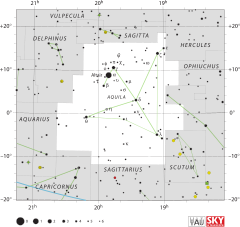| Observation data Epoch J2000 Equinox J2000 | |
|---|---|
| Constellation | Aquila |
| Right ascension | 19h 44m 34.19086s[1] |
| Declination | +13° 18′ 10.0063″[1] |
| Apparent magnitude (V) | 6.25[2] |
| Characteristics | |
| Spectral type | B9 III-IV[3] |
| U−B color index | –0.22[4] |
| B−V color index | –0.04[4] |
| Astrometry | |
| Radial velocity (Rv) | –18.3[5] km/s |
| Proper motion (μ) | RA: +0.561[1] mas/yr Dec.: –9.950[1] mas/yr |
| Parallax (π) | 2.8253 ± 0.0752 mas |
| Distance | 1,150 ± 30 ly (354 ± 9 pc) |
| Absolute magnitude (MV) | −1.17[6] |
| Details | |
| Radius | 3.7[7] R☉ |
| Luminosity | 341[6] L☉ |
| Temperature | 10,814±232[8] K |
| Rotational velocity (v sin i) | 20[9] km/s |
| Age | ~247[10] Myr |
| Other designations | |
| Database references | |
| SIMBAD | data |
Psi Aquilae, Latinized as ψ Aquilae, is the Bayer designation for a star in the equatorial constellation of Aquila. It is a faint star with an apparent visual magnitude of 6.25,[2] which, according to the Bortle Dark-Sky Scale, can be seen with the naked eye in dark rural skies. The orbit of the Earth causes an annual parallax shift of 2.83 mas,[1] which indicates a distance of approximately 1,150 light-years (350 parsecs).
The spectrum of Psi Aquilae matches a stellar classification of B9 III-IV,[3] with the luminosity class of III-IV indicating the spectrum lies part way between that of a subgiant and a giant star. The effective temperature of the star's outer atmosphere is 10,814 K,[8] giving it the blue-white hue of a B-type star.[11] It has nearly four[7] times the radius of the Sun and has a projected rotational velocity of 20 km/s.[9]
YouTube Encyclopedic
-
1/4Views:20 160341 22622 948634
-
Convegno Aisor Seconda Giornata - 11/09/2021
-
Constable, ASI - For PSI: IPC (Indian Criminal Act): Part 5 FROM ANGEL ACADEMY BY SAMAT GADHAVI SIR
-
नागरी हक्क अधिनियम - 1955 Nagari hakka sanrakshan kayda mpsc cdpo psi act
-
Feel The Markets 22.03.2022, invitat Mircea Fulga, COO Norofert Group
Transcription
References
- ^ a b c d e Brown, A. G. A.; et al. (Gaia collaboration) (August 2018). "Gaia Data Release 2: Summary of the contents and survey properties". Astronomy & Astrophysics. 616. A1. arXiv:1804.09365. Bibcode:2018A&A...616A...1G. doi:10.1051/0004-6361/201833051. Gaia DR2 record for this source at VizieR.
- ^ a b c "psi Aql -- Star", SIMBAD, Centre de Données astronomiques de Strasbourg, retrieved 2012-07-21.
- ^ a b Cowley, A. (November 1972), "Spectral classification of the bright B8 stars", Astronomical Journal, 77: 750–755, Bibcode:1972AJ.....77..750C, doi:10.1086/111348.
- ^ a b Crawford, D. L. (February 1963), "U, b, v, and Hβ Photometry for the Bright B8- and B9-TYPE Stars", Astrophysical Journal, 137: 530, Bibcode:1963ApJ...137..530C, doi:10.1086/147526.
- ^ Evans, D. S. (June 20–24, 1966), Batten, Alan Henry; Heard, John Frederick (eds.), "The Revision of the General Catalogue of Radial Velocities", Determination of Radial Velocities and their Applications, Proceedings from IAU Symposium no. 30, University of Toronto: International Astronomical Union, vol. 30, p. 57, Bibcode:1967IAUS...30...57E.
- ^ a b Anderson, E.; Francis, Ch. (2012), "XHIP: An extended hipparcos compilation", Astronomy Letters, 38 (5): 331, arXiv:1108.4971, Bibcode:2012AstL...38..331A, doi:10.1134/S1063773712050015, S2CID 119257644.
- ^ a b Pasinetti Fracassini, L. E.; et al. (February 2001), "Catalogue of Apparent Diameters and Absolute Radii of Stars (CADARS) - Third edition - Comments and statistics", Astronomy and Astrophysics, 367 (2): 521–524, arXiv:astro-ph/0012289, Bibcode:2001A&A...367..521P, doi:10.1051/0004-6361:20000451, S2CID 425754.
- ^ a b Paunzen, E.; Schnell, A.; Maitzen, H. M. (December 2005), "An empirical temperature calibration for the Δa photometric system. I. The B-type stars", Astronomy and Astrophysics, 444 (3): 941–946, arXiv:astro-ph/0509049, Bibcode:2005A&A...444..941P, doi:10.1051/0004-6361:20053546, S2CID 119436374.
- ^ a b Abt, Helmut A.; Levato, Hugo; Grosso, Monica (July 2002), "Rotational Velocities of B Stars", The Astrophysical Journal, 573 (1): 359–365, Bibcode:2002ApJ...573..359A, doi:10.1086/340590.
- ^ Gontcharov, G. A. (November 2012), "Spatial distribution and kinematics of OB stars", Astronomy Letters, 38 (11): 694–706, arXiv:1606.09028, Bibcode:2012AstL...38..694G, doi:10.1134/S1063773712110035, S2CID 119108982.
- ^ "The Colour of Stars", Australia Telescope, Outreach and Education, Commonwealth Scientific and Industrial Research Organisation, December 21, 2004, archived from the original on March 18, 2012, retrieved 2012-01-16

